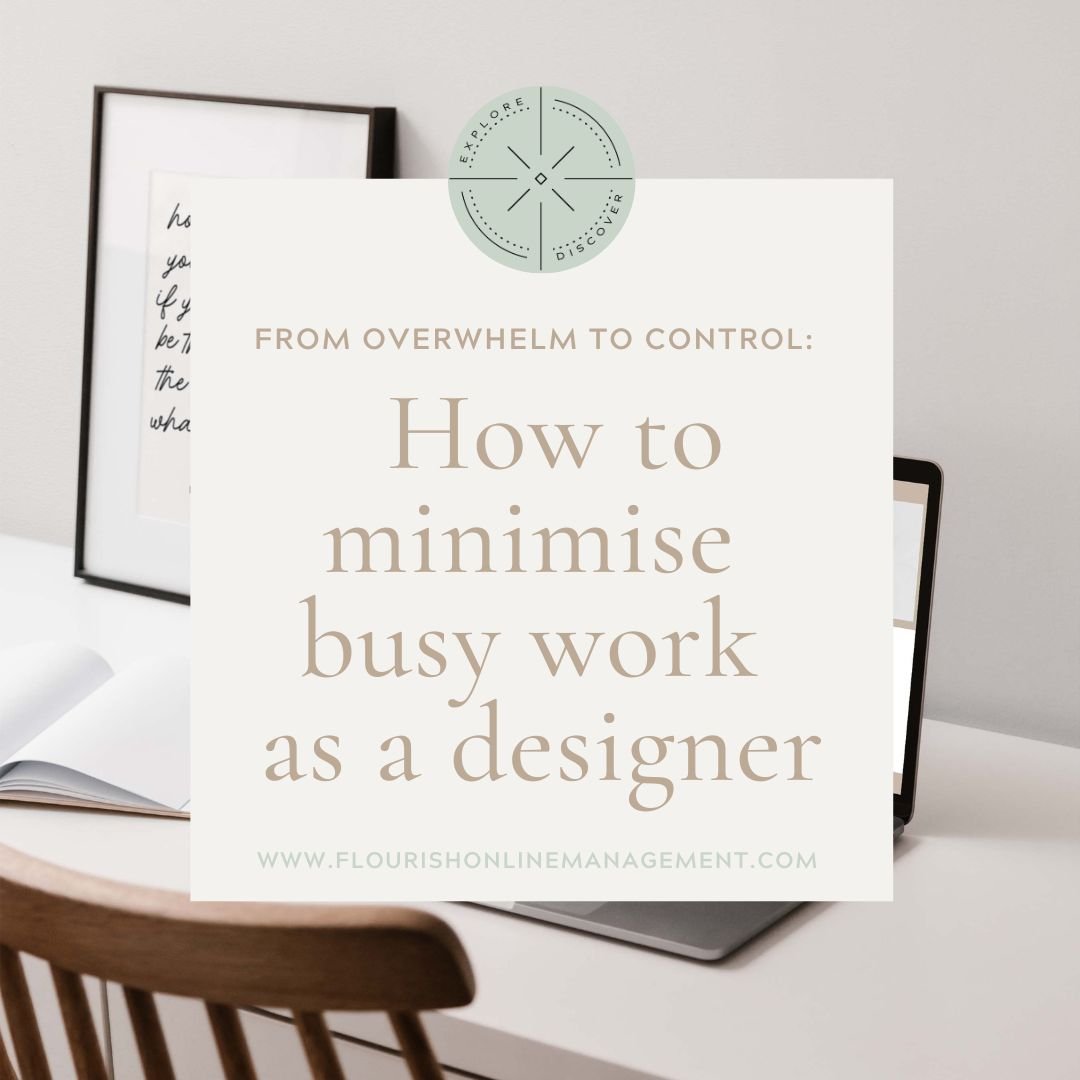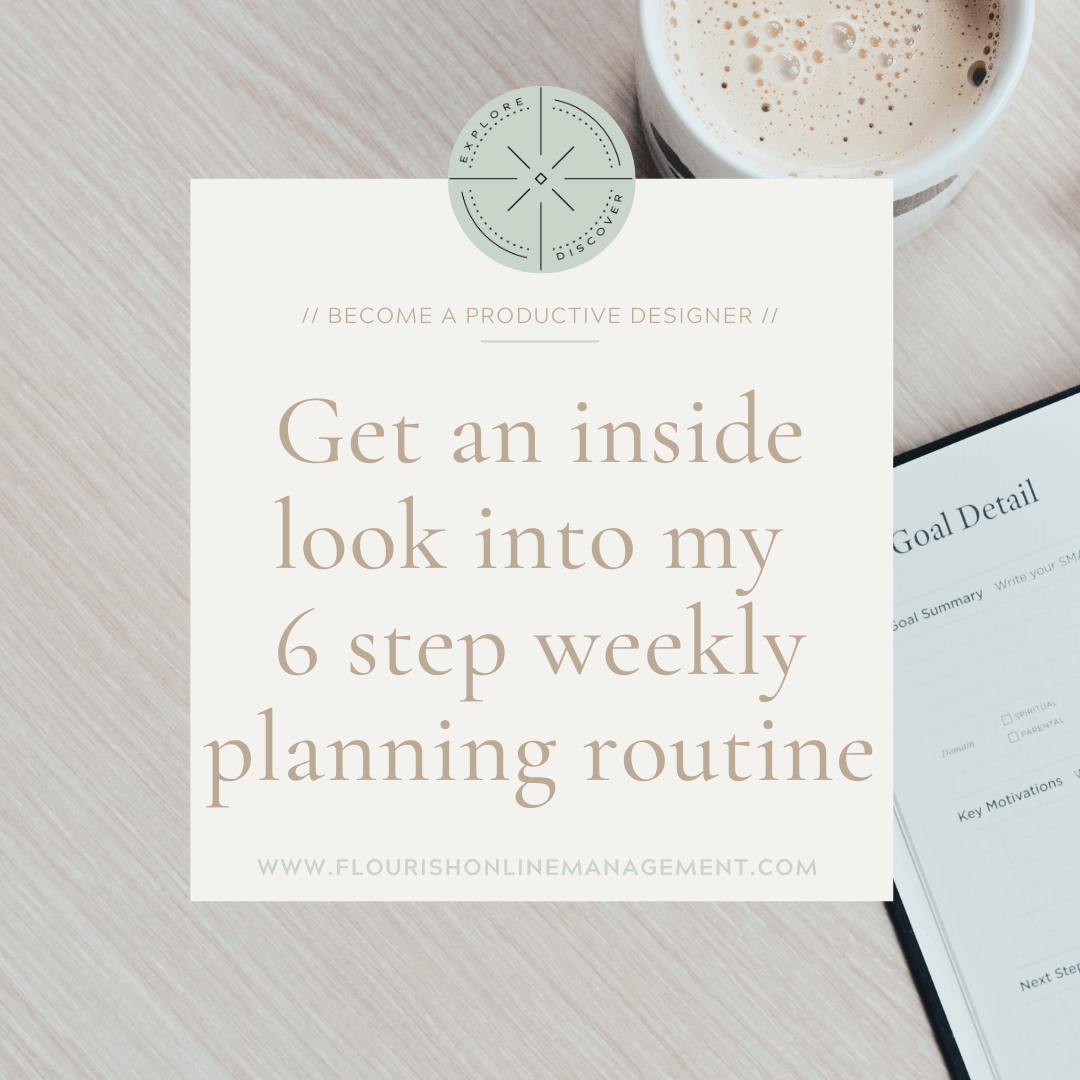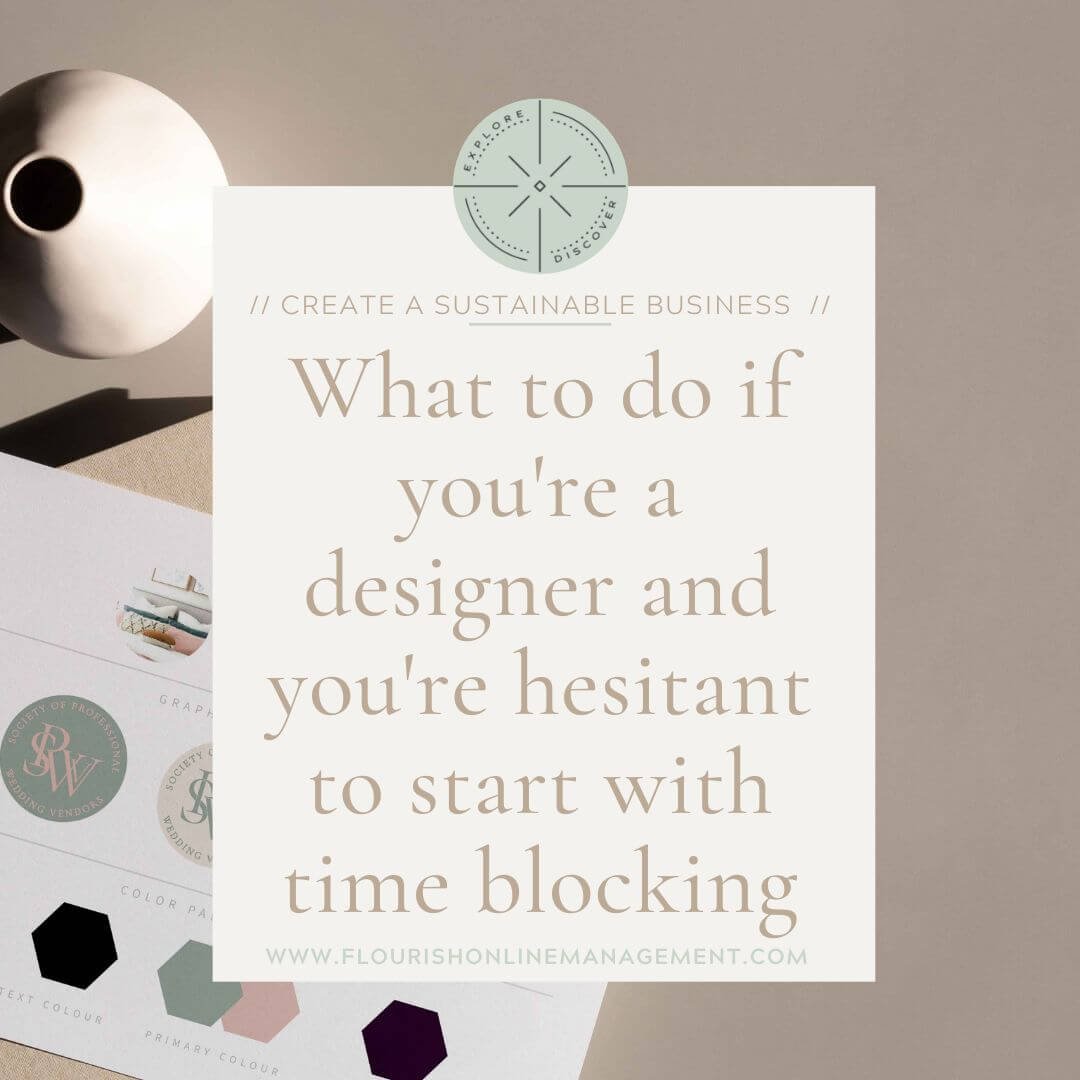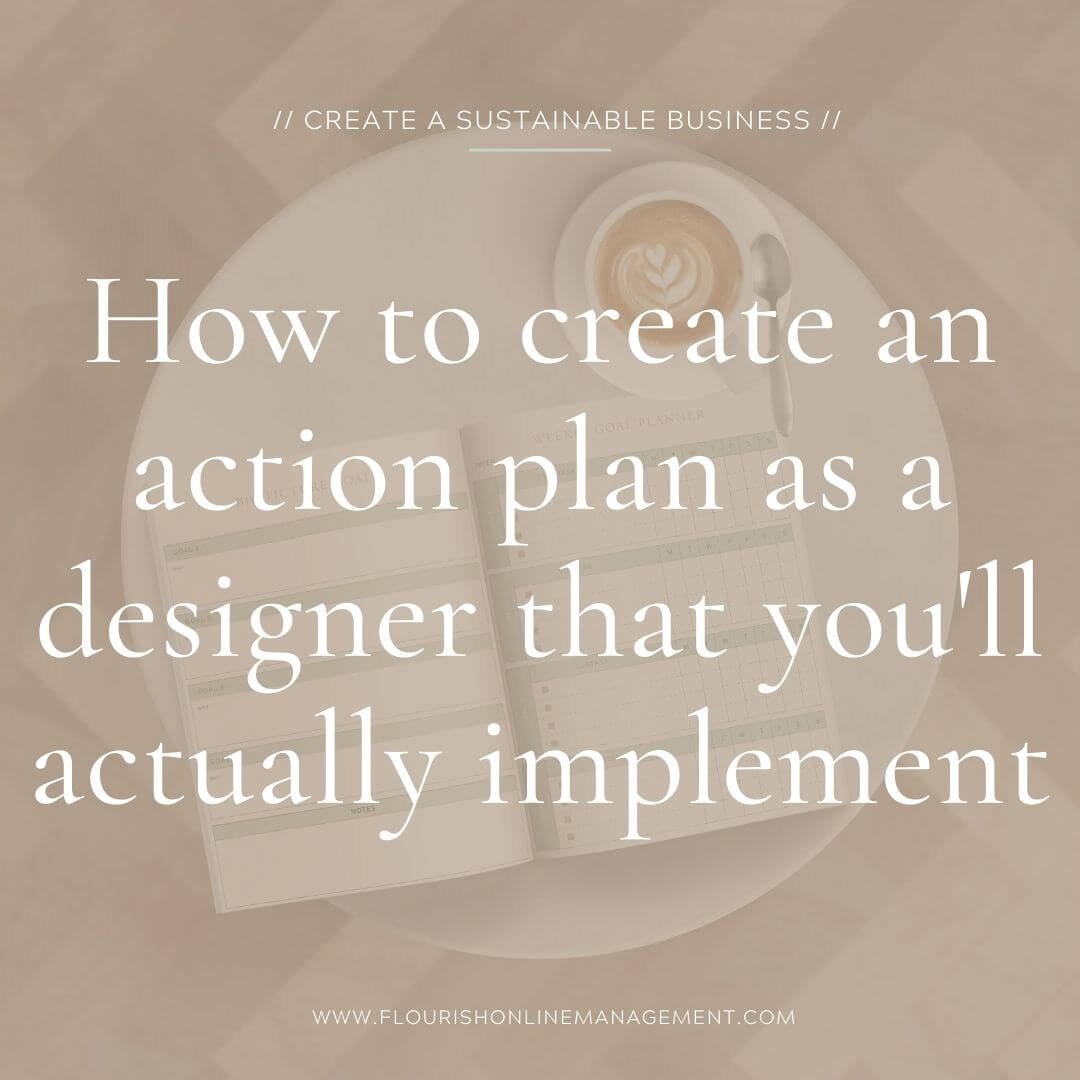How to create an action plan as a designer that you’ll actually implement
Working for yourself can be great because you have no one telling you what to do, but it can also be really hard for that same reason; there is no one else to hold you accountable to achieve your goals.
And you've probably noticed that it's one thing to have an action plan to optimise and streamline your client processes, increase your pricing or launch a new service, but that it's a whole other thing to consistently keep taking action to complete the steps on your action plan. Especially when design projects take up most of your time.
Let's make sure this does not happen to you.
Here are 4 things to consider when creating an action plan to make sure you'll actually implement the action steps so that you can transform your design studio to be more aligned, profitable and sustainable:
You need a solid action plan not just a long to-do list with random tasks
Make sure you built time into your weekly schedule to implement the action steps
Ensure you have a way to be held accountable for implementing your action plan
Have a monthly review process to assess progress and adjust course if needed
You need a solid action plan not just a long to-do list with random tasks
To give yourself the best chance to reach your goals you need to have a solid action plan, not just a long to-do list with random tasks on it.
Why?
Everything in your business is connected. You can't for example, look at the pricing of your design packages without knowing your revenue goals, how many hours you want to work per week and year, how much time you're spending on your design projects and what your hourly rate is.
As you can see from this example, there is a lot to consider when you want to change the pricing of your design packages in a way that will help to make your business more sustainable and profitable in the long run.
I want to stay with this example of increasing the pricing of your design packages, but let's start with the big picture goals for your design business and then work backwards.
THE BIG PICTURE
Let's say this year you are making 30.000 in revenue with your design studio. But you have crunched the numbers and have realised that for you to make your business more sustainable and support you with the way you want to live your life, you need to make 50.000 in revenue.
BREAKING DOWN THE BIG PICTURE GOAL
Going from 30k to 50K is quite a big jump. Especially when you have been able to make this 30K with only one-on-one work because there are only so many clients you can take on at the same time. And there is a large chance there's quite a bit that you need to change, improve or develop in your design business to get to this number.
So let's look at 2 strategies to increase your revenue:
Launch brand strategy related services like clarity calls or brand audits
Increase the pricing for your design packages
When you want to start offering new services it means that you have to develop these new services/products which takes a lot of time (and often even more than expected), especially if you're fully booked most of the year. Add in additional education, like a program about brand strategy because you want to feel more comfortable with brand strategy before you start offering this and you can add in a couple more months. And then I am not even considering if you also have the right audience to offer these new services.
The new services will be a long term strategy. But increasing your pricing can be achieved quicker, but it might not get you to 50K directly as you might need to increase pricing in phases. So what you can do instead of working towards the end goal of 50.000 is break down your goal into more achievable steps. This is something I like to call creating a phased approach.
A phased approach means that you set a goal but then break it up into smaller goals. This doesn't mean that you're just breaking down the goals into actionable steps to reach the goal but that you have smaller goals on the way to your bigger goal.
In this example, you can create a phased approach and set your next goal at 40.000. Then the action plan that you're creating to raise the prices of your design packages is geared toward achieving this 40.000 goal. This does not mean you're not working towards your ultimate goal. Everything that you will put in place to reach your 40K is also necessary to reach the 50K.
In another blog, I go into more detail about how you can use a phased approach if your big goals seem to be unreachable or make you feel overwhelmed and give phased approach examples of creating a full product suite and selling and marketing your services.
THE ACTION PLAN
So now you know that phase 1 of getting to 50K will be achieved by increasing your pricing (to get to 40K) and that phase 2 will be to start offering new services. So all you need to do now is focus on phase 1.
Can you imagine just having 1 clear focus on what to work on?
This is why I love working with a phased approach. We tend to have huge to-do lists that jump from one thing to the next in our business because you see everything that you need to do, should do and could do (which could even overwhelm you to the point where you don't do anything) that it's hard to know what is a priority. But these lists often also don't address all of the elements (like in the pricing example above) that need to be looked at. While with a phased approach you not only have 1 clear focus, you also don't have to worry about the could do's because you know what you should do. And working with sub-goals will help to lower the pressure on yourself.
Now you will need to break down the steps of this phase 1 and in which order to take these steps so that you know that what you are working on is going to help you achieve your goals. The steps for this example would be:
How much profit are you making now?
How many hours do you want to work per week and year?
What is your revenue goal? (you already know this one)
How much time are you spending completing your design projects?
How much time are you spending on improving your business?
What does your hourly rate need to be based on this information?
What profit margin will you add to your hourly rate?
What will the price of your design packages be based on your new hourly rate?
How many times do you need to sell each of your design packages to achieve your new target revenue of 40k?
What is your plan to make this happen?
Related post: The 4 weekly processes you need to determine what to work on in your sprints
Make sure you built time into your weekly schedule to implement the action steps
Your business can very easily become the opposite of the vision you had when you started your business. Instead of your business giving you more freedom to travel or spend time with family, it can be that it ties you to your desk for 40,60, maybe even 80 hours a week where you'd not just work during the day, but you also work weekends or evenings.
So you know something needs to change, but if you only work on optimising or streamlining your business when you have time left, the chance you will reach these goals is quite slim. So you will need to make sure you have a weekly block of time that is dedicated to working on your business.
In The One Thing by Gary Keller, he says “The people who achieve extraordinary results don’t achieve them by working more hours … They achieve them by getting more done in the hours they work.”
And one of the ways he teaches you to make sure the things that need to get done actually get done is by saying “Until my ONE Thing is done — everything else is a distraction.”
When we relate this to running your own business, he means that every day you first need to focus on what needs to happen for you aka the tasks that will move the needle in your business. And only when this is done, do you focus on other things aka client work.
And I know this is a huge mindset shift to make and might even feel impossible. So even here you can implement a phased approach. The first step would be to start structuring your week using theme days, task batching and time blocks. Which would need to include a time block that is dedicated to working on your action plan.
In another blog, I go into more detail about how to use theme days and time blocking to structure your week.
Wednesday can be a great day to add this. It's not at the start of the week. You don't want to add it at the start of your week if currently, client work is all you're working on as getting frustrated on a Monday because you don't have enough time can impact your whole week. And when you do it on a Friday it's very easy to not do it if you haven't finished all the client work you wanted to.
Then if you feel this is working well, phase 2 can be to add more hours to your 'work on the business block'. And phase 3 can be to move these blocks to be the first thing you work on in the morning. These are just suggestions and it's important to find a structure that works for you. As long as you make sure you don't leave optimising or streamlining your business up to chance.
Another benefit of these dedicated time blocks is that you will be able to plan according to your capacity. What I mean by that is that when you know exactly how much time you have you can make sure you only plan tasks that fit within that time block (with the help of time tracking) and not overcommit. This will help you to feel like you have finished everything you needed for your business when you have finished the tasks for that week's time block.
So instead of looking at this huge to-do list (which does not consider how much time you have that week to work on your business) where you were only able to cross off a few things and all you can see are those tasks that did not get completed (which makes you feel you did not get anywhere) you completed exactly what you were supposed to. And just this alone makes it worth working this way.
Want to get an inside look at how I plan my weeks? You can find that here.
Ensure you have a way to be held accountable for implementing your action plan
One of the things most of my clients say when I ask them why they are interested in my mentor program is that they are looking for accountability. When you take a self-study course, are part of a large group program or hire someone to create an action plan for you, there is no one there to hold you accountable for finishing the course or program (I know I have some courses that I never finished and you probably have them too).
So to increase your chances of you achieving your goals you need to have accountability but this does not have to come from just you. Studies have shown that people are 65% more likely to reach their goals when they’ve shared them with someone else.
And I see how well accountability works with my mentoring clients all the time. In the 3-months we work together they take more action and implement more in their business than they did in the 6-months and sometimes even the year before we started working together.
And I have experienced it myself as well. Since June 2020, I have had a weekly meeting with an accountability partner. Every week I can't wait to share wins or vent about something that I am struggling with. Knowing that there is someone who understands exactly what I am going through and can help me see a different perspective or help me come up with a plan.
Have a monthly review process to assess progress and adjust course if needed
Now that you know what you're working towards you need to check in with your progress and plan for the month ahead. A great way to do this is with a monthly review process so that you can make sure you are making decisions for your business based on data instead of on feelings or assumptions.
I have written a blog about 5 steps to perform a monthly business review as a designer where I go into more detail so I'll keep it short.
What will you look at during a monthly review?
Monthly review questions like what was your biggest achievement, what lessons have you learned and what can/should you adjust moving forward?
Track your metrics like for your website traffic, email marketing and social media
Update your financials so that you have a clear overview of how much revenue you made per service, what your expenses were and your profit.
Review your goals by evaluating the top 3 goals of the previous month
And planning for the next month so that you can determine your big 3 tasks/goals per week (and can break these up into actionable steps if needed)
AND THERE YOU HAVE IT
There you have it, 4 things to consider when creating an action plan to make sure you'll implement the action steps so that you can transform your design studio to be more aligned, profitable and sustainable.
If you thought this post you might also like:











































